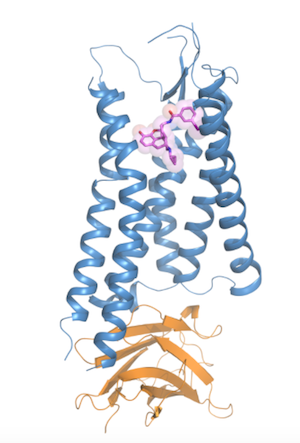- Center on Health Equity and Access
- Clinical
- Health Care Cost
- Health Care Delivery
- Insurance
- Policy
- Technology
- Value-Based Care
Molecular Discovery Moves Scientists Closer to Designing Pain Relief Without Side Effects
Researchers have made a key discovery that could pave the way to designing an improved opioid to relieve pain without the risk of addiction and side effects.
Researchers have made a key discovery that could pave the way to designing an improved opioid to relieve pain without the risk of addiction and side effects.
The research, published Thursday in the journal Cell, details how scientists solved the crystal structure of the activated kappa opioid receptor (KOR) bound to a morphine derivative. They then created a new drug-like compound that activates only the KOR.
The development of an opioid that targets only that receptor could mean pain relief without the risk of nausea, numbness, constipation, anxiety, severe dependency, hallucinations, and even death caused by respiratory depression. Currently, most opioids bind to several opioid receptors on the surface of cells, causing those side effects.
In addition, drugs targeting only KORs can have other side effects, such as hallucinations and dysphoria (a general state of unease or dissatisfaction with life related to anxiety and depression). By understanding how the KOR is activated, researchers have discovered how to bind a compound to KORs to only relieve pain and avoid side effects.

Illustration of the active state kappa opioid receptor bound to a morphine derivative (purple). Credit: Tao Che and Daniel Wacker, Roth Lab, UNC School of Medicine.
The University of North Carolina (UNC) School of Medicine led the research, in conjunction with University of Southern California (USC) and other collaborators.
“To create better opioids, we need to know the structure of their receptors," senior author Bryan Roth, MD, PhD, the Michael Hooker Distinguished Professor of Protein Therapeutics and Translational Proteomics in the Department of Pharmacology at UNC-Chapel Hill, said in a statement. "Until recently, this was impossible. But now we know the structure of the activated kappa opioid receptor. And we showed we can actually use the structure to make a drug-like compound with better properties than current opioids."
The work was done in cell cultures in Roth's lab. Two postdoctoral fellows in Roth's lab led the research: first author Tao Che, PhD, and corresponding author Daniel Wacker, PhD, who worked with several other scientists at UNC and elsewhere.
With the structure in place, researchers “can use this to design better compounds in ways not previously possible,” Roth said in an email to The American Journal of Managed Care®. Currently, the researchers are identifying better compounds before moving into animal studies.
"One of the big ideas is to target KORs because the few drugs that bind to it don't lead to addiction or cause death due to overdose. Those side effects are mainly related to actions at the mu opioid receptor," he said.
Receptors are proteins on the surface of cells. About 40% of drugs currently on the market target G-protein coupled receptors, or GPCRs, such as KORs. To figure out the chemical structure of the opioid receptor, the researchers had to go beyond X-ray crystallography, which allows scientists to see a 3D molecular structure from a crystal.
Opioid receptors are tiny, and they do not sit still when bound to a ligand, or drug-like compound, as required in X-ray crystallography. To overcome this difficulty, researchers used Lipidic Cubic Phase crystallization. The process suspends KOR molecules in specially designed water-lipid mixtures and then slowly removes the water.
Experimental methods were used to make sure the receptors were absolutely still, including the use of a tiny antibody to "prop up" the receptor in its active state bound to a ligand—a derivative of morphine created by Sush Majumdar, PhD, at Memorial Sloan Kettering Cancer Center. Once they had the crystal structure, Che, Wacker, and colleagues could see which parts of the receptor were important for binding to drug-like compounds.
Collaborators at USC used computer models of ligands to see which parts they could chemically modify to make the ligands more likely to bind tightly to KORs but not to other receptors. With those modifications made, they synthesized a new compound and showed in lab tests that it is extremely selective for KORs.
The research was funded by the National Insitutes of Health as well as the Mayday Fund and the Peter F. McManus Trust.
Besides the UNC School of Medicine and USC, other collaborators included RTI International, Virginia Commonwealth University, Arizona State University, the Institute of Natural Resources and Environmental Audits in China, and Vrije Universiteit Brussels in Belgium.
Reference
Che T, Majumdar S, Zaidi S, et al. Structure of the nanobody-stabilized active state of the kappa opioid receptor. Cell. 2018;(172):1-13. doi: 10.1016/j.cell.2017.12.011
How Can Digital Care Programs Aid Those With Chronic Musculoskeletal Pain?
June 9th 2020On this episode of Managed Care Cast, we speak with Jeffrey Krauss, MD, chief medical officer of Hinge Health and Stanford Clinical assistant professor, about the efficacy of a 12-week digital care program aimed to reduce lower back and knee pain in a real-world population.
Listen
Understanding the Impact of Inappropriate Opioid Prescribing Practices
April 19th 2019Deaths from drug overdoses have become the leading cause of death for Americans under age 50, which can largely be attributed to prescription opioids. Due to the role of prescription opioids, understanding prescribing patterns and identifying inappropriate prescribing are crucial for changing the course of the epidemic.
Listen
MBSR Reduced Pain Perception in Patients With Migraine
December 19th 2020The finding about mindfulness-based stress reduction (MBSR) was a secondary outcome of the double-blinded, randomized, placebo-controlled clinical trial. The primary outcome—a reduction in the frequency of migraines—was not reached.
Read More
